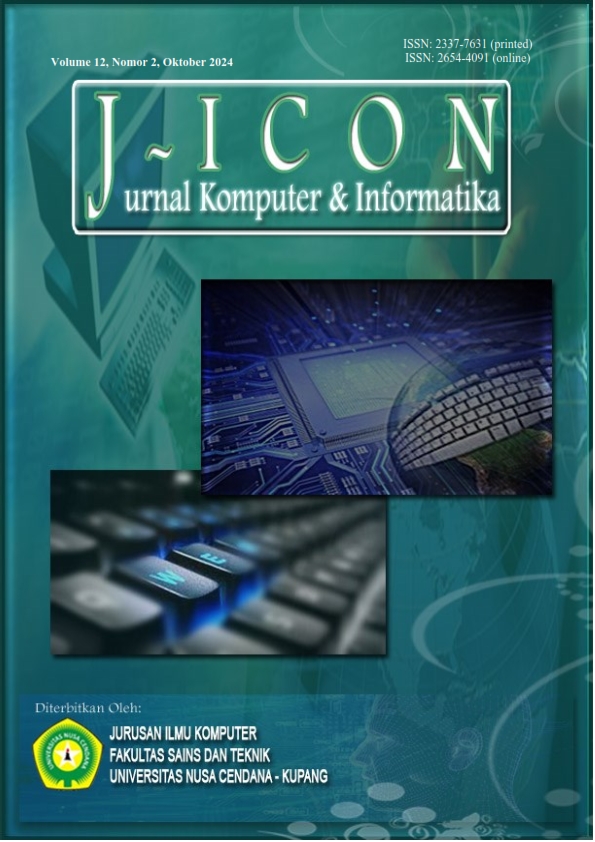Detection Model of Microalgae Spirulina platensis and Chlorella vulgaris Based on Convolutional Neural Network YOLOv8
Abstract
Microalgae are unicellular microscopic organisms that live in various water. Microalgae such as Spirulina platensis and Chlorella vulgaris are grown due to their potential as bioenergy source. During cultivation, typically, hemocytometers are used to manually count the cells and that is time-consuming and prone to human error. This research aims to develop microalgae detection model based on microscopic images and Convolutional Neural Network using YOLOv8 architecture. The methodology includes sample preparation (dilution and optical density measurement), best density determination, image acquisition, annotation, creation of datasets, YOLOv8 model training, and model performance evaluation. Best density determines good microscopic images. Image acquisition was done using binocular microscope and acquired 560 images which were then annotated. The YOLOv8n, YOLOv8s, and YOLOv8m models were trained using default hyperparameters on Google Collaboratory to determine the augmentation effect on model accuracy. Model performance evaluation was done on selected YOLOv8 models. The results showed the augmentation (crop, brightness, blur) get the highest mAP train and test on YOLOv8m model, which are 0.945 and 0.913. The YOLOv8m model was retrained with various hyperparameters and it was found that the best configuration was SGD optimizer, epoch 50, and learning rate 0.01 with mAP train and test are 0.934 and 0.925. However, 29 epochs yielding a better model with accuracy of 0.8535, minimising overfitting and resource wastage. This research can facilitate the more efficient and automatic counting for microalgae-related research and industry.
Downloads
References
V. Dolganyuk, D. Belova, O. Babich, A. Prosekov, S. Ivanova, D. Katserov, N. Patyukov, and S. Sukhikh, “Microalgae: A promising source of valuable bioproducts,” Biomolecules, vol. 10, no. 8, pp. 1-24, Aug. 2020. doi: https://doi.org/10.3390/biom10081153.
H. V. Mendonça, P. Assemany, M. Abreu, E. Couto, A. M. Maciel, R. L. Duarte, M. G. B. Santos, and A. Reis, “Microalgae in a global world: New solutions for old problems?,” Renewable Energy, vol. 165, pp. 842-862, 2021. doi: 10.1016/j.renene.2020.11.014.
D. T. Zewdie and A. Y. Ali, “Cultivation of microalgae for biofuel production: Coupling with sugarcane-processing factories,” Energy, Sustainability and Society, vol. 10, no. 1, pp. 1-16, 2020. doi: 10.1186/s13705-020-00262-5.
V. S. Braga, J. B. Moreira, J. A. V. Costa, and M. G. Morais, “Enhancement of the carbohydrate content in Spirulina by applying CO2, thermoelectric fly ashes and reduced nitrogen supply,” International Journal of Biological Macromolecules, vol. 123, pp. 1241-1247, 2019.
H. Chowdhury and B. R. Loganathan, “Third-generation biofuels from microalgae: A review,” Current Opinion in Green and Sustainable Chemistry, vol. 20, pp. 39-44, 2019. doi: 10.1016/j.cogsc.2019.09.003.
T. Takahashi, “Potential of an automated- and image-based cell counter to accelerate microalgal research and applications,” Energies, vol. 13, pp. 1-11, 2020. doi: https://doi.org/10.3390/en13226019.
V. E. Dökümcüoğlu and M. Yılmaz, “Assessment of cell counting method based on image processing for a microalga culture,” Mediterranian Fisheries and Aquaculture Research, vol. 3, no. 1, pp. 75-81, 2020.
S. Patel and A. Patel, “Object detection with convolutional neural networks,” Machine Learning for Predictive Analysis Lecture Notes in Networks and Systems, pp. 529-539, 2020. doi: https://doi.org/10.1007/978-981-15-7106-0_52.
S. S. Baek, J. C. Pyo, Y. Pachepskyb, Y. Park, M. Ligaray, C. Y. Ahn, Y. H. Kim, J. A. Chun, and K. H. Cho, “Identification and enumeration of cyanobacteria species using a deep neural network,” Ecological Indicators, vol. 115, pp. 1-10, 2020. doi: https://doi.org/10.1016/j.ecolind. 2020.106395.
X. Jiang, A. Hadid, Y. Pang, E. Granger, and X. Feng, Deep learning in object detection and recognition. Singapore: Springer Nature, 2019.
E. Soylu and T. Soylu, “A performance comparison of YOLOv8 models for traffic sign detection in the Robotaxi-full scale autonomous vehicle competition,” Multimedia Tools and Applications, pp. 1-31, 2023. doi: 10.1007/s11042-023-16451-1.
X. Zhai, Z. Huang, T. Li, H. Liu, and S. Wang, “YOLO-drone: An optimized YOLOv8 network for tiny UAV object detection,” Electronics, vol. 12, no. 17, pp. 2-21, 2023. doi: https://doi.org/10. 3390/electronics12173664.
S. Zhou, J. Jiang, X. Hong, P. Fu, and H. Yan, “Vision meets algae: A novel way for microalgae recognization and health monitor,” Front. Mar. Sci., pp. 1-10, 2023. doi: 10.3389/fmars.2023.1105545.
T. Yang, S. Zhou, A. Xu, J. Ye, and J. Yin, “An approach for plant leaf image segmentation based on YOLOV8 and the improved DEEPLABV3+,” Plants, vol. 12, no. 19, pp. 2-17, 2023. doi: https://doi.org/10.3390/plants12193438.
M. Wasil, H. Harianto, and F. Fathurrahman, “Pengaruh epoch pada akurasi menggunakan convolutional neural network untuk klasifikasi fashion dan furniture,” Infotek: Jurnal Informatika dan Teknologi, vol. 5, no. 1, pp. 53-61, 2022. doi: https://doi.org/10.29408/jit. v5i1.4393.
L. Zhang, G. Ding, C. Li, and D. Li, “DCF-YOLOv8: An improved algorithm for aggregating low-level features to detect agricultural pests and diseases,” Agronomy, vol. 13, no. 8, pp. 1-16, 2023. doi: https://doi.org/10.3390/agronomy13082012.
F. Khairati and H. Putra, “Prediksi kuantitas penggunaan obat pada layanan kesehatan menggunakan algoritma backpropagation neural network,” Jurnal Sistim Informasi dan Teknologi, vol. 4, no. 3, pp. 128-135, 2022. doi: https://doi.org/10.37034/jsisfotek.v4i3.158.
E. C. Adjobo, A. T. S. Mahama, P. Gouton, and J. Tossa, “Automatic localization of five relevant dermoscopic structures based on YOLOv8 for diagnosis improvement,” J. Imaging, vol. 9, no. 7, pp. 1-18, 2023. doi: https://doi.org/10.3390/jimaging9070148.
S. Dong, P. Wang, and K. Abbas, “A survey on deep learning and its applications,” Computer Science Review, vol. 40, pp. 1-22, 2021. doi: https://doi.org/10.1016/j.cosrev.2021.100379.
A. Sarda, S. Dixit, A. Bhan, Object detection for autonomous driving using YOLO [you only look once] algorithm: Third International Conference on Intelligent Communication Technologies and Virtual Mobile Networks (ICICV), February 4-6, 2021, Tirunelveli, India. 2021.
Copyright (c) 2024 Zahra Cahya Ramadhani, Dimas Firmanda Al Riza

This work is licensed under a Creative Commons Attribution 4.0 International License.
The author submitting the manuscript must understand and agree that if accepted for publication, authors retain copyright and grant the journal right of first publication with the work simultaneously licensed under a Creative Commons Attribution (CC-BY) 4.0 License that allows others to share the work with an acknowledgment of the work’s authorship and initial publication in this journal.
 Zahra Cahya Ramadhani(1*)
Zahra Cahya Ramadhani(1*)




